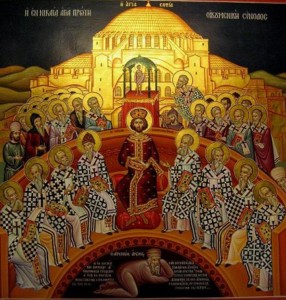Introduction to the Creed

The following is an introduction to a multi-edition series which will focus on our Creed.
The Creed is one of the most ancient prayers of the Orthodox Church. The word creed comes from the Latin credo which means “I believe.” The early Christians realised the need for a public, authoritative interpretation of the Bible that remained faithful to what Christ taught and what the Apostles intended.
It was needed to instruct new converts, nurture the believers and protect the church against false teachings.
It was composed, through the inspiration of the Holy Spirit, by the Fathers of the First and Second Ecumenical Councils, at a time when various heretical doctrines attempted to overthrow the true faith in the Trinity.
The main reason for the convening of the First Ecumenical Council (Nicea 325 AD), under the auspices of Emperor Constantine the Great and with 318 Bishops in attendance, was the appearance and growing strength of the false teaching of the Alexandrian priest, Arius. It potentially could have split the Byzantine empire. The basic theory of his false teaching was that the Son of God was created, that His existence had a beginning, and that He was inferior to the Father.
The Second Ecumenical Council (Constantinople 381AD) condemned the false teaching of the Pneumatomachi (Adversaries of the Spirit), whose chief representative was Macedonius, Archbishop of Constantinople. The Pneumatomachi called the Holy Spirit the servant and fulfiller of God’s wishes and they did not recognize Him as a Hypostasis (Person) of the Holy Trinity.
“The doctrinal definitions of an Ecumenical Council are infallible. Thus in the eyes of the Orthodox Church, the statements of faith put out by the seven councils possess, along with the Bible, an abiding and irrevocable authority.” The Orthodox Church (Timothy Ware [p.202])
The Holy Church made a decisive stand to protect the purity of the Christian faith, setting out the basic saving truths of Christian teaching in the Creed, which is supposed to be a constant guide for all Christians in their spiritual life. It was agreed to never change it. It has remained unchanged in our Orthodox Tradition.
It is recited during the Divine Liturgy, in many of the prayer services of the faithful such as the Midnight Office, morning prayers and Compline and is the official confession of faith made by a person or his godparent at his baptism.
It is a “symbol of faith” stating what we believe as Christians. It covers major themes of scripture including Creation, the Trinity, and Redemption. Each statement has its source from the Bible. We recite it together to show that we are united in heart and mind in our beliefs about God.
The Creed itself is divided into twelve articles, seven of which were formulated at the First Ecumenical Council, the other five at the Second.
The Creed is as follows:
- I believe in one God, Father Almighty, maker of heaven and earth, and of all things visible and invisible.
- And in one Lord Jesus Christ, the only-begotten Son of God, begotten of the Father before all ages, light from light, true God from true God, begotten not made, of one essence with the Father; through whom all things were made.
- Who for us and for our salvation came down from heaven, and was incarnate of the Holy Spirit and the Virgin Mary, and became human,
- and was crucified for us under Pontius Pilate, and suffered and was buried,
- and rose on the third day according to the Scriptures,
- and ascended into heaven, and is seated at the right hand of the Father,
- and will come again in glory to judge the living and the dead, and his kingdom will have no end.
- And in the Holy Spirit, the Lord, the giver of life, who proceeds from the Father, who together with the Father and the Son is worshipped and glorified, and who spoke through the Prophets.
- In one holy, catholic, and apostolic Church.
- I acknowledge one baptism for the forgiveness of sins.
- I expect the resurrection of the dead,
- and the life of the age to come. Amen.
In the following issues we will enter a journey in which we will explore each article in more detail.
Source: Lychnos August–September 2020
